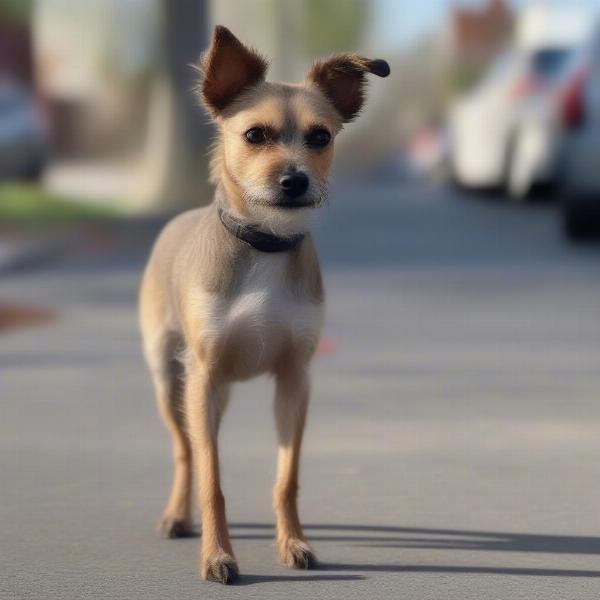Dog tails aren’t just cute appendages; they’re sophisticated communication tools. Understanding what your dog is trying to tell you through their tail wags, postures, and movements can deepen your bond and help you anticipate their needs. This article explores the nuances of dog tail language, from the excited thumps of a happy pup to the subtle signals of anxiety or fear.
Decoding the Wag: What Your Dog’s Tail is Saying
A wagging tail isn’t always a sign of happiness. While a loose, wide wag often signifies joy and excitement, a stiff, high-held wag can be a sign of alertness or even dominance. A slow wag, especially with the tail held low, can indicate uncertainty or apprehension. Paying attention to the speed, direction, and height of the wag is crucial to understanding your dog’s emotional state.
 Dog with tail tucked between its legs
Dog with tail tucked between its legs
The Tail Tuck: A Sign of Fear or Submission
A tucked tail, held tightly between the legs, is a classic sign of fear or submission. This posture makes the dog appear smaller, minimizing its perceived threat to others. If your dog tucks their tail, it’s important to approach them calmly and gently, avoiding any sudden movements or loud noises that could further frighten them.
Tail Height and Movement: Subtle Signals
The height at which a dog holds its tail can also provide valuable insights. A tail held high often signifies confidence and alertness, while a tail held at a mid-level position is usually a neutral or relaxed posture. The direction of the wag can also offer clues. A wag that leans more to the right side of the body often indicates positive emotions, while a left-leaning wag can suggest anxiety or negativity. These subtle differences can help you fine-tune your understanding of your dog’s communication.
Why Do Dogs Wag Their Tails?
Dogs wag their tails primarily as a form of communication, expressing a range of emotions from joy and excitement to fear and anxiety. The movement of the tail helps distribute scent from glands located near the base of the tail, further enhancing communication with other dogs. This complex system of signals allows dogs to navigate social interactions and establish hierarchies within their packs.
Interpreting Tail Language in Different Breeds
While the general principles of tail language apply across most breeds, certain breeds have unique tail characteristics that can influence interpretation. For instance, some breeds naturally have curled or tightly coiled tails, making it harder to discern subtle changes in posture. It’s essential to consider breed-specific traits when analyzing tail language.
Conclusion: Listening to Your Dog’s Tail
By learning to interpret the subtle nuances of dog tail language, you can gain a deeper understanding of your furry friend’s emotions and needs. Paying attention to the speed, height, and direction of the wag, along with the overall posture of the tail, can provide valuable insights into your dog’s internal state. This knowledge can help you strengthen your bond and create a more harmonious relationship with your canine companion.
FAQ
- Does a wagging tail always mean a dog is happy? No, while often associated with happiness, a wagging tail can also signify other emotions like alertness, anxiety, or even dominance.
- Why does my dog tuck its tail between its legs? This is typically a sign of fear, anxiety, or submission.
- What does a high-held tail indicate? A high-held tail generally suggests confidence and alertness.
- Do all dogs communicate the same way with their tails? While the general principles are similar, breed-specific tail characteristics can influence interpretation.
- How can I learn more about dog body language? Observing your dog’s behavior in different situations and consulting with a professional dog trainer can be helpful.
- What should I do if my dog’s tail language suddenly changes? If you notice any significant changes in your dog’s tail posture or movements, it’s best to consult with a veterinarian to rule out any underlying medical conditions.
- Is it important to understand dog tail language? Yes, understanding dog tail language can enhance your bond and help you better anticipate your dog’s needs.
ILM Dog is a leading international website dedicated to providing expert advice on dog care and wellbeing. We offer a wealth of resources on everything from breed selection and training to nutrition, health, grooming, and travel. We also offer expert advice on choosing the right products and accessories for your furry friend. Whether you’re a new dog owner or a seasoned expert, ILM Dog is your go-to resource for all things canine. Contact us today for personalized advice! Email: [email protected] Phone: +44 20-3965-8624.